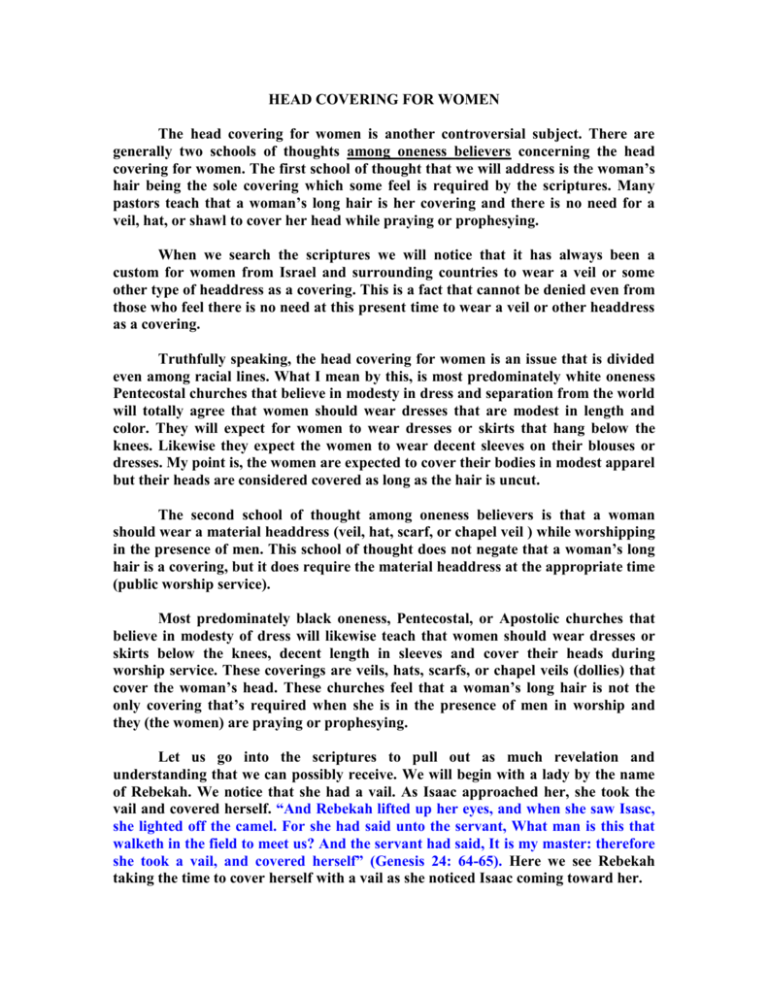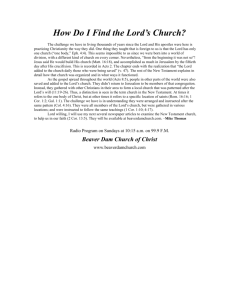HEAD COVERING FOR WOMEN - True Deliverance Apostolic Church
advertisement

HEAD COVERING FOR WOMEN The head covering for women is another controversial subject. There are generally two schools of thoughts among oneness believers concerning the head covering for women. The first school of thought that we will address is the woman’s hair being the sole covering which some feel is required by the scriptures. Many pastors teach that a woman’s long hair is her covering and there is no need for a veil, hat, or shawl to cover her head while praying or prophesying. When we search the scriptures we will notice that it has always been a custom for women from Israel and surrounding countries to wear a veil or some other type of headdress as a covering. This is a fact that cannot be denied even from those who feel there is no need at this present time to wear a veil or other headdress as a covering. Truthfully speaking, the head covering for women is an issue that is divided even among racial lines. What I mean by this, is most predominately white oneness Pentecostal churches that believe in modesty in dress and separation from the world will totally agree that women should wear dresses that are modest in length and color. They will expect for women to wear dresses or skirts that hang below the knees. Likewise they expect the women to wear decent sleeves on their blouses or dresses. My point is, the women are expected to cover their bodies in modest apparel but their heads are considered covered as long as the hair is uncut. The second school of thought among oneness believers is that a woman should wear a material headdress (veil, hat, scarf, or chapel veil ) while worshipping in the presence of men. This school of thought does not negate that a woman’s long hair is a covering, but it does require the material headdress at the appropriate time (public worship service). Most predominately black oneness, Pentecostal, or Apostolic churches that believe in modesty of dress will likewise teach that women should wear dresses or skirts below the knees, decent length in sleeves and cover their heads during worship service. These coverings are veils, hats, scarfs, or chapel veils (dollies) that cover the woman’s head. These churches feel that a woman’s long hair is not the only covering that’s required when she is in the presence of men in worship and they (the women) are praying or prophesying. Let us go into the scriptures to pull out as much revelation and understanding that we can possibly receive. We will begin with a lady by the name of Rebekah. We notice that she had a vail. As Isaac approached her, she took the vail and covered herself. “And Rebekah lifted up her eyes, and when she saw Isasc, she lighted off the camel. For she had said unto the servant, What man is this that walketh in the field to meet us? And the servant had said, It is my master: therefore she took a vail, and covered herself” (Genesis 24: 64-65). Here we see Rebekah taking the time to cover herself with a vail as she noticed Isaac coming toward her. It is obvious that her body was already covered with clothing, so the vail was to cover her head. Women of that time would cover their heads as a sign of modesty. God yet requires women to portray modesty through their clothing and a material headdress during public worship services. In my searching of the scriptures I notice when a woman covered [her face] she was thought to be a harlot. This is why we don’t teach the women to cover their faces as the Muslims teach. The Bible says, “And she (Tamar) put her widow’s garments off from her, and covered her with a vail, and wrapped herself, and sat in an open place, which is by the way to Timnath; for she saw that Shelah was grown, and she was not given unto him to wife. When Judah saw her, he thought her to be an harlot; because she had covered her face” (Genesis 38: 14-15). Notice that Judah thought his own daughter in law was a harlot because she covered her face (a practice among many Muslim women). Evidently in those days a woman who covered her face was thought to be a harlot. Another scripture which signifies that women of old covered their heads is found in the book of Numbers, “And the priest shall set the woman before the LORD, and uncover the woman’s head, and put the offering of memorial in her hands, which is the jealousy offering: and the priest shall have in his hand the bitter water that causeth the curse:” (Numbers 5: 18). In order for the woman’s head to be uncovered it had to first be covered! Note: Most scriptures in the Bible which pertains to a man or woman having their head covered speaks of a material headdress of some sort. (Genesis 24:65, 2 Samuel 15:30, Jeremiah 14:3-4, 1Corinthians 11:4, 6, 7). Though (1 Corinthians 11:15) refers to a woman’s long hair as a covering, this does not negate the material headdress that should be worn during public worship. We will notice some of the customs which were observed by the patriarchs of old and verify that these same customs became practices or ordinances in the New Testament Church. The custom of Melchizedek bringing forth bread and wine (Genesis 14: 18). “And Melchizedek king of Salem brought forth bread and wine: and he was the priest of the most high God” Jesus made this custom of old, an ordinance in the New Testament (Matthew 26: 2629). Apostle Paul continued this (ordinance) according to (1 Corinthians 11: 23-29). “And as they were eating, Jesus took bread, and blessed it, and brake it, and gave it to the disciples, and said, Take, eat; this is my body. And he took the cup, and gave thanks, and gave it to them, saying, Drink ye all of it; For this is my blood of the new testament, which is shed for many for the remission of sins. But I say unto you, I will not drink henceforth of this fruit of the vine, until that day when I drink it new with you in my Father’s kingdom” “For I have received of the Lord that which also I delivered unto you, That the Lord Jesus the same night in which he was betrayed took bread: And when he had given thanks, he brake it, and said, Take, eat: this is my body, which is broken for you: this do in remembrance of me. After the same manner also he took the cup, when he had supped, saying, This cup is the new testament in my blood: this do ye, as oft as ye drink it, in remembrance of me. For as often as ye eat this bread, and drink this cup, ye do shew the Lord’s death till he come. Wherefore whosoever shall eat this bread, and drink this cup of the Lord, unworthily, shall be guilty of the body and blood of the Lord. But let a man examine himself, and so let him eat of that bread, and drink of that cup. For he that eateth and drinketh unworthily, eateth and drinketh damnation to himself, not discerning the Lord’s body” Note: This custom which was first established by Abraham and Melchizedek is now an ordinance in the New Testament Church. The custom of Abraham giving tithes to Melchizedek priest of the Most High God (Genesis 14: 20). “And blessed be the most high God, which hath delivered thine enemies into thy hand. And he gave him tithes of all” Jesus continued this practice even during his earthly life (Matthew 23:23). Also the apostle Paul continued this practice in the church (1Corinthians 9:14). “Woe unto you, scribes and Pharisees, hypocrites! For ye pay tithe of mint and anise and cummin, and have omitted the weightier matters of the law, judgment, mercy, and faith: these ought ye to have done, and not to leave the other undone” “Even so hath the Lord ordained that they which preach the gospel should live of the gospel” Note: This custom of giving tithes was first established by Abraham and Melchizedek and is now practiced in the Church. The custom of giving water to visitors for foot washing was practice in the Old Testament (Genesis 18:4, 19: 2, 24:32, 43:24). “Let a little water, I pray you, be fetched, and wash your feet, and rest yourselves under the tree” “And he said, Behold now, my lords, turn in, I pray you, into your servant’s house, and tarry all night, and wash your feet, and ye shall rise up early, and go on your ways. And they said, Nay; but we will abide in the street all night” “And the man came into the house: and he ungirded his camels, and gave straw and provender for the camels, and water to wash his feet, and the men’s feet that were with him” And the man brought the men into Joseph’s house, and gave them water, and they washed their feet; and he gave their asses provender” Jesus took this custom (ordinance) to another level when he washed his disciples feet and commanded them to do so to one another (John 13: 4-17). Likewise apostle Paul required widows indeed to have washed the saints feet (1Timothy 5: 10). “He riseth from supper, and laid aside his garments, and took a towel, and girded himself. After that he poureth water into a bason, and began to wash the disciples’ feet, and to wipe them with the towel wherewith he was girded. Then cometh he to Simon Peter: and Peter saith unto him, Lord, dost thou wash my feet? Jesus answered and said unto him, What I do thou knowest not now; but thou shalt know hereafter. Peter saith unto him, Thou shalt never wash my feet. Jesus answered him, If I wash thee not, thou hast no part with me. Simon Peter saith unto him, Lord, not my feet only, but also my hands and my head. Jesus saith to him, He that is washed needeth not save to wash his feet, but is clean every whit: and ye are clean, but not all. Note: The practiced of washing feet was established under the Old Testament but is now likewise practiced in the New Testament Church. The custom of women covering their heads with a vail (material headdress) was practiced under the Old Testament (Genesis 24:65). It was also practiced and required during the worship (church) services when a woman would pray or prophesy (1Corinthians 11:2-16). Note: The custom or practice of women covering their heads was established under the Old Testament and is now likewise practiced in the New Testament Church. My point is these are early customs that we can trace back to the Old Testament and each one of them can be seen and justified in the church. The wearing of head coverings (veil, shawl, hat, scarf, and so forth) is not a custom that originated with the Catholic Church as some suggest, but as we can plainly see through a search of the scriptures, these customs have been in existence for many years before Catholicism ever came into existence. The Catholic Church took the tradition of head coverings (material headdress) and perverted it by commanding women (Nuns) to all wear the same color of headdress and take a vow of celibacy. It became a uniform to declare these women as chaste and totally dedicated to the Lord. They even took on uniformity in their names. Each nun is called Sister Mary_______________________. The Holy Scriptures require that the spiritual women in the church follow the pattern of the women of old, even following the example of Sarah who was Abraham’s wife. “For after this manner in the old time the holy women also, who trusted in God, adorned themselves, being in subjection unto their own husbands: Even as Sara obeyed Abraham, calling him lord: whose daughters ye are, as long as ye do well, and are not afraid with any amazement” (1 Peter 3: 5-6). In conclusion, the wearing of head coverings (material headdress) is a biblical fact which is backed up by the Holy Scriptures. No where in the Bible is a veil, hat, shawl, or scarf ever condemned or defined as an artificial covering. They are always spoken of as a covering upon a woman’s or man’s head. As many Oneness who believe in modest apparel when it comes to wearing long dresses or skirts with long sleeve blouses, yet their heads are completely uncovered according to the scriptures. A (material headdress) is commanded by God to be worn by women during worship services. If a man wore a hat, veil, shawl, or scarf into the sanctuary, he would be considered as having his head covered. Therefore during worship services all women should have their head covered (material headdress) as a sign of obedience to the Word of God. Don’t allow anyone to make you feel inferior or ignorant because you are willing to cover (material headdress) your head during worship services. If long hair is the only covering God’s Word is requiring, what about those women who hair texture doesn’t grow to extremely long lengths? Are we to condemn them because the length of their hair is not long enough to our pleasing? We encourage all saved women to let their hair grow to its fullest extent. This is pleasing in the eyes of the Lord. There are some churches which have long hair contests for women. Where in the Bible are we commanded to have long hair contests for the sisters in church [NO WHERE]? What God meant to be a glory (beauty) to women, have become a source of pride in many church circles. Let us abide by the scriptures, for there is a blessing in being obedient to the Word of God. All women should wear a head covering (material headdress) in the worship services and dress in modest apparel. Bishop D. E. Hall, Th.M, Th.D








